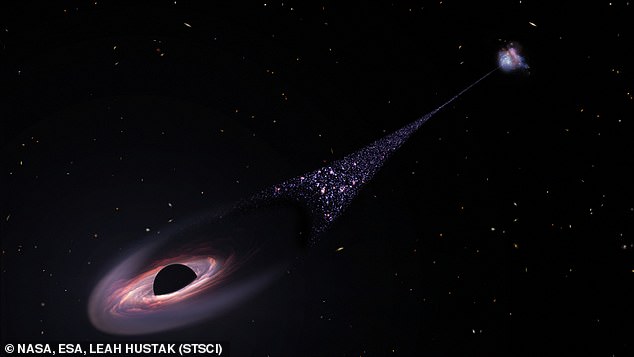
NASA has warned that there’s an ‘invisible monster on the loose’, in the form of a ‘runaway’ black hole.
The supermassive black hole is barrelling through the universe so quickly that if it were in our solar system, it could travel the 237,674-mile journey from Earth to the Moon in just 14 minutes.
Weighing as much as 20 million suns, the black hole has left a trail of stars in its wake, measuring a whopping 200,000-light-years – twice the diameter of the Milky Way.
‘We think we’re seeing a wake behind the black hole where the gas cools and is able to form stars,’ said Professor Pieter van Dokkum, lead author of the study from Yale University.
‘So, we’re looking at star formation trailing the black hole.’


NASA has warned that there’s an ‘invisible monster on the loose’, in the form of a ‘runaway’ black hole (artist’s impression)
While you might imagine a black hole gobbling up stars ahead of it, analysis with NASA’s Hubble Space Telescope found that this isn’t the case.
Instead, the black hole, which is 7.5 billion light-years from Earth, is ploughing into gas in front of it, triggering star formation.
‘What we’re seeing is the aftermath,’ Professor van Dokkum explained. ‘Like the wake behind a ship we’re seeing the wake behind the black hole.’
Hubble’s images show that the black hole lies at one end of a column, which stretches back to its parent galaxy.
The outermost tip of this column contains a ‘remarkably bright knot of ionised oxygen’, which the researcher suggest is probably the result of heat from the motion of the black hole.
‘Gas in front of it gets shocked because of this supersonic, very high-velocity impact of the black hole moving through the gas,’ Professor van Dokkum said.
‘How it works exactly is not really known.’
Professor van Dokkum stumbled across the black hole while scanning Hubble images for globular star clusters in a nearby galaxy.
‘I was just scanning through the Hubble image and then I noticed that we have a little streak,’ he explained.
‘I immediately thought, ‘oh, a cosmic ray hitting the camera detector and causing a linear imaging artifact.’


A supermassive black hole lies at the tip of the bridge at lower left. The black hole was ejected from the galaxy at upper right. It compressed gas in its wake to leave a long trail of young blue stars
‘When we eliminated cosmic rays we realized it was still there. It didn’t look like anything we’ve seen before.’
The researchers believe the runaway black hole escaped after two galaxies merged around 50 million years ago, bringing together the supermassive black holes at their centres.
Then, when a third galaxy came along with its own black hole, the three mixed, leading to a ‘chaotic and unstable configuration’.
One of the black holes likely stole momentum from the other two and got thrown out of its host galaxy.
As the runaway black hole took off in one direction, the two remaining black holes shot of in the other direction, according to the researchers.
The team now hopes to use NASA’s James Webb Space Telescope to study the black hole further, and confirm this explanation.








